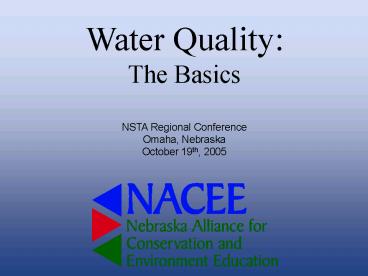Water Quality: - PowerPoint PPT Presentation
1 / 13
Title:
Water Quality:
Description:
Why is Water Quality Important? Effects all humans. Safe drinking water. Allows for food productions and SAFE food products. Effects Wildlife ... – PowerPoint PPT presentation
Number of Views:53
Avg rating:3.0/5.0
Title: Water Quality:
1
Water Quality The Basics NSTA Regional
Conference Omaha, Nebraska October 19th, 2005
2
- Why is Water Quality Important?
- Effects all humans
- Safe drinking water
- Allows for food productions and SAFE food
products - Effects Wildlife
- Health domestic and wild animals
- Diversity of Life (insects or
- macroinvertebrates)
- Recreation
- Swimming
- Water Sports
- Fishing
3
- What determines the Quality of Water?
- Individual test parameters
- pH
- Temperature
- Dissolved Oxygen
- Clarity
- Turbidity
- Secchi
- Total Nitrogen
- Total Phosphorus
- Salinity
- Alkalinity
4
pH pH Negative logarithm of the hydrogen ion
concentration pH -log H
H OH- OH- OH- H OH- H H H OH-
H H H OH- H H OH- OH-
H H H
Each whole pH below 7 is ten times more acidic
than the next higher value. For example, a pH of
4 is ten times more acidic than a pH of 5. The
same holds true for pH values above 7. Each value
above 7 is ten times more basic than the next
lower pH value.
5
- Temperature
- Important because
- Dissolved Oxygen
- Temperature Dissolved Oxygen
- -Decreases in Dissolved Oxygen can cause
problems - for wildlife (ex. fish kills)
- Fluctuations can cause problems for many plants
which moves up the food web.
6
Dissolved Oxygen A measure of free O2 (gas) in
the water. lt5 ppm dangerous zone 5 10 ppm
adequate zone gt10 ppm good
7
Clarity Turbidity A measure of the suspended
solids, which reduce the transmission of light
through scattering or absorption. Secchi Measur
ing how far down a person can see the secchi
disk. Somewhat objective, but fairly accurate.
Easy to discuss results among non-scientists.
8
- Nitrogen
- Nitrogen is a nutrient, like calcium or
potassium. - Nitrogen is available in the environment
naturally. - The problem is when more is added fertilizers
- or confinements.
9
Phosphorus
- Phosphorus is also a nutrient, like nitrogen,
calcium, - or potassium.
- It is also available in the environment
naturally, but - phosphorus is more limiting in freshwater
ecosystems. - Adding too much phosphorus (making it no linger
limiting) - can cause algal blooms.
10
- Salinity
- A measurement of the salt content in the water
- lt 5 psu freshwater
- gt 5 psu brackish water
- gt 32 psu sea water
- Not necessarily table salt (NaCl)
- - Examples of salts sodium calcium magnesium,
- potassium, sulfate, and chloride.
- - All dissolved from geologic materials
- rocksthe bottom of the lake.
11
- Conductivity
- A measure of the electromagnetic charge of the
water. - Measures the electrical charge between two
electrodes (metal rods) in the water. - -For there to be an electrical charge, there
must be free ions or dissolved salts (TDS). - -The higher the TDS or free ions, the
more electrical current that can occur,
causing higher conductivity.
134 uS
12
- Alkalinity
- The ability of a lake (or body of water) to
buffer from - changes in pH.
- Causes in changes in pH
- discharge
- plant productivity
- animal waster, processes
- Why is alkalinity important?
- Drastic or constant changes in pH can cause
problems for the biota of the lakes ecosystem.
ACID
13
Questions?































